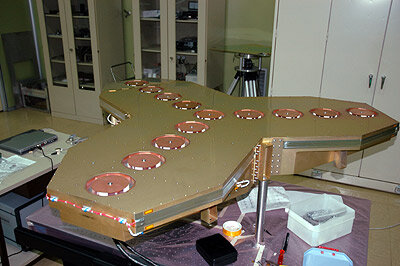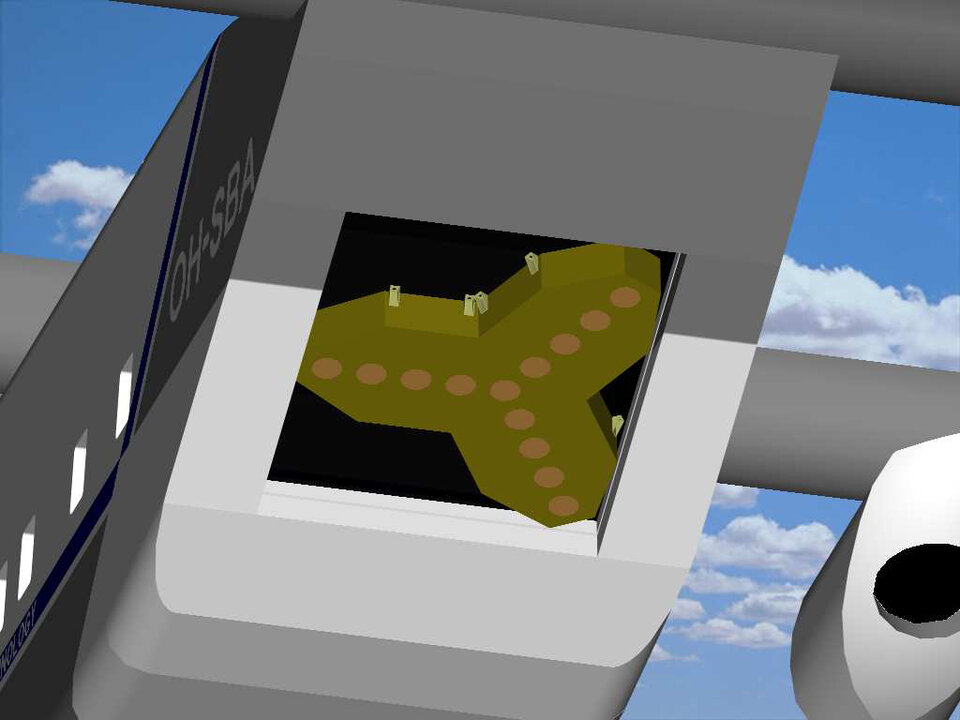Airborne version of SMOS instrument takes shape
The development of a new instrument is nearing completion, that, when operated from an aircraft will provide scientists with data similar to those expected from the SMOS (Soil Moisture and Ocean Salinity) mission.
SMOS, due for launch in 2007, will provide much-needed global maps of soil moisture and ocean salinity by employing a novel radiometer called MIRAS (Microwave Imaging Radiometer using Aperture Synthesis). Through the principles of interferometry MIRAS will measure microwave radiation emitted from the Earth's surface at L-band (1.4 GHz). Since MIRAS is based on new technology, the measuring techniques need to be tested in a number of pre-launch campaigns by flying a demonstrator that can make similar measurements from an aircraft.
For this purpose, the hardware that was originally produced during the predevelopment phase of the SMOS mission has been integrated into a new instrument comprising a Y-shaped array that houses 4 antenna elements per arm. The spaceborne MIRAS radiometer will be much bigger, carrying a total of 69 antenna elements – the so-called LICEF receivers.

A number of field activities in support of the SMOS mission have already been successfully carried out such as the recent coSMOS campaign in Australia. However, as this new instrument is an interferometer, it will be the closest thing to SMOS ever flown on an aircraft.
Despite its promise of delivering excellent data, the instrument doesn't seem to have acquired a proper name yet. Some refer to it by its contract name MDPP-3, some call it AMIRAS (Airborne MIRAS) or SAM (Small Airborne MIRAS), and since it is being developed in Spain by EADS-CASA Espacio it is sometimes called SMOSillo (little SMOS in Spanish).
Whatever it ends up being called, this instrument will be able to take measurements in horizontal and vertical polarisations, and like SMOS, in dual- and full-polarisation modes. Even the viewing geometry will be similar to that of SMOS; positioned in the cargo bay of an aircraft the backward tilt angle is 24 degrees with the same array orientation with respect to the ground and the same spacing between the antenna elements. Among other similarities, the LICEF-2 receivers on the demonstrator instrument provide frequency responses very close to those of the LICEF flight models of MIRAS, with a bandwidth of 19 MHz centred at 1413.5 MHz.

The instrument is now about to be integrated into the interface structure that will allow it to eventually fit into the Skyvan aircraft belonging to Helsinki University of Technology (HUT), Finland.
It will then undergo some performance and antenna pattern tests at the anechoic chamber of the Polytechnic University of Catalonia (UPC), Spain, which are necessary to interpret the measurements correctly. Following which, a 'cold sky' measurement will be carried out in a facility near the mouth of the River Ebro for further verification. Finally, the instrument will be installed in the Skyvan aircraft, tested that everything is in working order and taken on its maiden campaign flight early this summer.
EADS-CASA Espacio (E) has taken the lead in the development of the instrument, with participation from MIER, IEEC and UPC (E), HUT and Elektrobit (FIN) and Astrium-Ottobrunn (D). The activity has been co-funded by the GSTP programme and the SMOS project.




